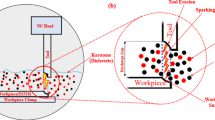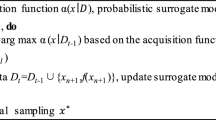Abstract
In this article, the low-pressure die-cast (LPDC) process parameters of aluminum alloy thin-walled component with permanent mold are optimized using a combining artificial neural network and genetic algorithm (ANN/GA) method. In this method, an ANN model combining learning vector quantization (LVQ) and back-propagation (BP) algorithm is proposed to map the complex relationship between process conditions and quality indexes of LPDC. The genetic algorithm is employed to optimize the process parameters with the fitness function based on the trained ANN model. Then, by applying the optimized parameters, a thin-walled component with 300 mm in length, 100 mm in width, and 1.5 mm in thickness is successfully prepared and no obvious defects such as shrinkage, gas porosity, distortion, and crack were found in the component. The results indicate that the combining ANN/GA method is an effective tool for the process optimization of LPDC, and they also provide valuable reference on choosing the right process parameters for LPDC thin-walled aluminum alloy casting.











Similar content being viewed by others
References
B. Zhang, D.M. Maijer, and S.L. Cockcroft, Development of a 3-D Thermal Model of the Low-Pressure Die-Cast (LPDC) Process of A356 Aluminum Alloy Wheels, Mater. Sci. Eng. A, 2007, 464, p 295–305
A.E. Miller and D.M. Maijer, Investigations of Erosive-Corrosive Wear in the Low Pressure Die Casting of Aluminum A356, Mater. Sci. Eng. A, 2006, 435–436, p 100–111
P.H. Fu, A.A. Luo, H.Y. Jiang, and L.M. Peng, Low-Pressure Die Casting of Magnesium Alloy AM50: Response to Process Parameters, J. Mater. Process. Technol., 2008, 205, p 224–234
J. You, Y.W. Wang, N.X. Feng, and M.S. Yang, Preparation of Casting Alloy ZL101 with Coarse Aluminum-Silicon Alloy, Trans. Nonferrous Met. Soc. China, 2008, 18, p 116–120
Z. Fan, X. Fang, and S. Ji, Microstructure and Mechanical Properties of Rheo-Diecast (RDC) Aluminum Alloys, Mater. Sci. Eng. A, 2005, 412, p 298–306
A. Mitrasinovic, F.C. Robles Hernandez, and M. Djurdjevic, On-Line Prediction of the Melt Hydrogen and Casting Porosity Level in 319 Aluminum Alloy Using Thermal Analysis, Mater. Sci. Eng., 2006, 428, p 41–46
S.P. Wu, C.Y. Li, and J.J. Guo, Numerical Simulation and Experimental Investigation of Two Filling Methods in Vertical Centrifugal Casting, Trans. Nonferrous Met. Soc. China, 2006, 16, p 1035–1040
T.R. Vijayaram, S. Sulaiman, and A.M.S. Hamouda, Numerical Simulation of Casting Solidification in Permanent Metallic Molds, J. Mater. Process. Technol., 2006, 178, p 29–33
L.A. Dobrzanski, M. Krupinski, and J.H. Sokolowski, Computer Aided Classification of Flaws Occurred During Casting of Aluminum, J. Mater. Process. Technol., 2005, 167, p 456–462
S. Deng and Y. Hwang, Applying Neural Networks to the Solution of Forward and Inverse Heat Conduction Problems, Int. J. Heat Mass Transf., 2006, 49, p 4732–4750
Y.C. Liang, D.P. Feng, G.R. Liu, X.W. Yang, and X. Han, Neural Identification of Rock Parameters Using Fuzzy Adaptive Learning Parameters, Comput. Struct., 2003, 81, p 2373–2382
L.Q. Zhang, L.X. Li, H. Ju, and B.W. Zhu, Inverse Identification of Interfacial Heat Transfer Coefficient Between the Casting and Metal Mold Using Neural Network, Energy Convers. Manag., 2010, 51, p 1898–1904
F. Pettersson, N. Chakraborti, and H. Saxen, A Genetic Algorithm Based Multi-Objective Neural Net Applied to Noisy Blast Furnace Data, Appl. Soft Comput., 2007, 7, p 387–397
F. Pettersson, A. Biswas, and P.K. Sen, Analyzing Leaching Data for Low-Grade Manganese Ore Using Neural Nets and Multiobjective Genetic Algorithms, Mater. Manuf. Process., 2009, 24, p 320–330
C.R. Chen and H.S. Ramaswamy, Modeling and Optimization of Variable Retort Temperature (VRT) Thermal Processing Using Coupled Neural Networks and Genetic Algorithms, J. Food Eng., 2002, 53, p 209–220
H. Kurtaran, B. Ozcelik, and T. Erzurumlu, Warpage Optimization of a Bus Ceiling Lamp Base Using Neural Network Model and Genetic Algorithm, J. Mater. Process. Technol., 2005, 169, p 314–319
W. Paszkowicz, Genetic Algorithms, a Nature-Inspired Tool: Survey of Applications in Materials Science and Related Fields, Mater. Manuf. Process., 2009, 24, p 174–197
C.A.C. Coello and R.L. Becerra, Evolutionary Multiobjective Optimization in Materials Science and Engineering, Mater. Manuf. Process., 2009, 24, p 119–129
K. Mitra, Genetic Algorithms in Polymeric Material Production, Design, Processing and Other Applications: A Review, Int. Mater. Rev., 2008, 53, p 275–297
N. Chakraborti, Genetic Algorithms in Materials Design and Processing, Int. Mater. Rev., 2004, 49, p 246–260
C.Y. Shen, L.X. Wang, and Q. Li, Optimization of Injection Molding Process Parameters Using Combination of Artificial Neural Network and Genetic Algorithm Method, J. Mater. Process. Technol., 2007, 183, p 412–418
A. Krimpenis, P.G. Benardos, G.C. Vosniakos, and A. Koukouvitaki, Simulation-Based Selection of Optimum Pressure Die-Casting Process Parameters Using Neural Nets and Genetic Algorithms, Int. J. Adv. Manuf. Technol., 2006, 27, p 509–517
J.H. Kuo, F.L. Hsu, and W.S. Hwang, Development of an Interactive Simulation System for the Determination of the Pressure-Time Relationship During the Filling in a Low Pressure Die Casting Process, Sci. Technol. Adv. Mater., 2001, 2, p 131–145
X. Han, D. Xu, and G.R. Liu, A Computational Inverse Technique for Material Characterization of a Functionally Graded Cylinder Using a Progressive Neural Network, Neurocomputing, 2003, 51, p 341–360
V.R. Adineh, C. Aghanajafi, G.H. Dehghan, and S. Jelvani, Optimization of the Operational Parameters in a FAST AXIAL Flow CW CO2 Laser Using Artificial Neural Networks and Genetic Algorithms, Opt. Laser Technol., 2008, 40, p 1000–1007
L.Q. Zhang, L.X. Li, and B.W. Zhu, Simulation Study on the LPDC Process for Thin-Walled Aluminum Alloy Casting, Materials and Manufacturing Process, 2009, 24, p 1349–1353
L.Y. Zhang, Y.H. Jiang, Z. Ma, and S.F. Shan, Effect of Cooling Rate on Solidified Microstructure and Mechanical Properties of Aluminium-A356 Alloy, J. Mater. Process. Technol., 2008, 207, p 107–111
H. Drar and I.L. Svensson, Improvement of Tensile Properties of Al-Si Alloys Through Directional Solidification, Mater. Lett., 2007, 61, p 392–396
Acknowledgments
The authors gratefully acknowledge research support from Hunan Science Fund for Distinguished Young Scholars No. 09JJ1007, International Cooperation and Exchanges MOST No.2008DFA50990 and the Science Fund of State Key Laboratory of Advanced Design and Manufacturing for Vehicle Body No. 60870005.
Author information
Authors and Affiliations
Corresponding author
Rights and permissions
About this article
Cite this article
Zhang, L., Li, L., Wang, S. et al. Optimization of LPDC Process Parameters Using the Combination of Artificial Neural Network and Genetic Algorithm Method. J. of Materi Eng and Perform 21, 492–499 (2012). https://doi.org/10.1007/s11665-011-9933-0
Received:
Revised:
Published:
Issue Date:
DOI: https://doi.org/10.1007/s11665-011-9933-0




